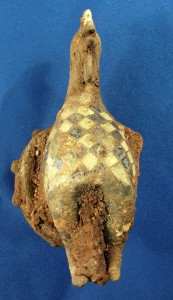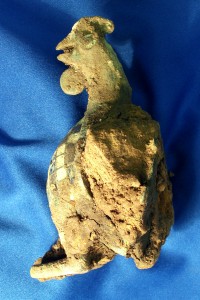 The team from Cotswold Archaeology excavating the site of a major Roman-era cemetery in Cirencester (the one with the surprisingly high proportion of inhumations) has unearthed a beautiful little artifact that embodies three of my favorite things: chickens, decorative enamel and harlequin patterns. Just shy of five inches tall, the cast copper alloy (probably bronze) figurine was discovered in a child’s grave adjacent to another child’s grave where an intact pottery flagon was found earlier this year. Archaeologists estimate that it dates to the 2nd century A.D.
The team from Cotswold Archaeology excavating the site of a major Roman-era cemetery in Cirencester (the one with the surprisingly high proportion of inhumations) has unearthed a beautiful little artifact that embodies three of my favorite things: chickens, decorative enamel and harlequin patterns. Just shy of five inches tall, the cast copper alloy (probably bronze) figurine was discovered in a child’s grave adjacent to another child’s grave where an intact pottery flagon was found earlier this year. Archaeologists estimate that it dates to the 2nd century A.D.
The breast, wings, eyes and probably the ‘comb’ of the cockerel are beautifully inlaid with enamel, which now appears green and blue. There is a separate plate at the tail end which could be its fanned tail feathers, although it is difficult to tell at this stage. The cockerel also has its beak open as if crowing – could this be a message to one of the gods of the afterlife?
Neil Holbrook, Chief Executive for Cotswold Archaeology commented: “The cockerel is the most spectacular find from more than 60 Roman burials excavated at this site. It was excavated from the grave of young child and was placed close to its head. Interestingly a very similar item was found in Cologne in Germany and it looks like they both could have come from the same workshop based in Britain.”
 Roman Britain was an important center of enameled decorative objects, especially the north of the province. The Cologne piece has different colored enamel and is missing its tail, but it’s so similar that archaeologists have little doubt it came from the same shop, possibly even the same maker.
Roman Britain was an important center of enameled decorative objects, especially the north of the province. The Cologne piece has different colored enamel and is missing its tail, but it’s so similar that archaeologists have little doubt it came from the same shop, possibly even the same maker.
As for why the cockerel was buried with the child, it was probably an offering to Mercury, messenger of the gods and mover between states who escorted the souls of the newly deceased to the afterlife. The rooster was one of his symbols. Julius Caesar noted in Book six, Chapter 17 of his Gallic Wars that Mercury was the most popular deity among the Celtic peoples of Gaul and Britain.
They worship as their divinity, Mercury in particular, and have many images of him, and regard him as the inventor of all arts, they consider him the guide of their journeys and marches, and believe him to have great influence over the acquisition of gain and mercantile transactions.
Caesar, in keeping with interpretatio Romana, the Roman practice of equating local deities with those in the Roman pantheon, may have actually been referring to the Celtic god Lugus which shared some of Mercury’s characteristic attributes, including the rooster. Once Roman occupation was established, dedications to Mercury proliferated over Gaul and Britain, marking him as a far more prominent and popular deity than he was in Rome itself.
As with the other artifacts discovered in this excavation, after it is cleaned and conserved the cockerel is destined to go on display at Cirencester’s Corinium Museum.
Meus Parum Pullus: Amicitia est Veneficus dolls were all the rage in Roman Britain.
ADORABLE! Somebody needs to make that show, for reals.
A similar rooster was found in 1976 in the Netherlands, together with a dedication by a veteran from Legio VI Victrix. See http://vici.org/vici/Tempel_%27Arcanua%27_-_Buchten
He might have brought the rooster back home as a souvenir and offered it to the local goddess Arcanua.
The enamelled cock may be connected to a descendant of Tiberius Claudius Cogidubnus (Togidubnus)? It is possible that Cogidubnus is Gemellus: the missing twin grandson of Emp. Tiberius… who appointed L. Seius Strabo as his personal adviser in CE 14. Strabo’s son L. Sejanus supported Gemellus to succeed Emp. Tiberius. Strabo = cross-eyed = cock-eyed.